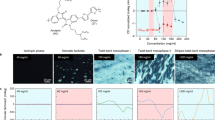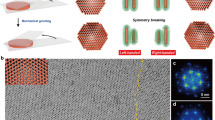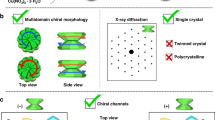Abstract
Homochirality is essential to many biological systems, and plays a pivotal role in various technological applications. The generation of homochirality and an understanding of its mechanism from the single-molecule to supramolecular level have received much attention. Two-dimensional chirality is a subject of intense interest due to the unique possibilities and consequences of confining molecular self-assembly to surfaces or interfaces. Here, we report the perfect generation of two-dimensional homochirality of porous molecular networks at the liquid–solid interface in two different ways: (i) by self-assembly of homochiral building blocks and (ii) by self-assembly of achiral building blocks in the presence of a chiral modifier via a hierarchical structural recognition process, as revealed by scanning tunnelling microscopy. The present results provide important impetus for the development of two-dimensional crystal engineering and may afford opportunities for the utilization of chiral nanowells in chiral recognition processes, as nanoreactors and as data storage systems.
This is a preview of subscription content, access via your institution
Access options
Subscribe to this journal
Receive 12 print issues and online access
$259.00 per year
only $21.58 per issue
Buy this article
- Purchase on Springer Link
- Instant access to full article PDF
Prices may be subject to local taxes which are calculated during checkout





Similar content being viewed by others
Change history
24 October 2014
In the version of this Article originally published, a systematic error in converting the energies obtained by molecular mechanics calculations to the total energies used to evaluate the relative stabilities of the molecular network models, led to incorrect energy values being reported. The correct values are as follows: In 'Control of homochirality in a porous molecular network', modelling of hexamers of cDBA-OC12-( S) CW structure was found to be 9.66 kcal mol-1 more stable than the CCW pattern. In 'Chiral induction in a porous molecular network', the difference between CW and CCW hexamers formed by five molecules of DBA-OC12 and one of cDBA-OC12-( S) was found to be only 0.24 kcal mol−1. In 'Hierarchical chiral induction mechanism', for cyclic hexamers of one chiral cDBA-OC12-( S )-OC13-( R) and five achiral DBA-OC12 on graphite, the CW hexagonal structure is favoured by 3.88 kcal mol−1. In comparison, in similar structures made from cDBA-OC12-( S )-OC13-( R) and DBA-OC13 the energy difference between the CW and CCW structures was only 1.33 kcal mol−1. These errors do not affect the conclusions of the work, and all of the values have been corrected in the online versions of the Article.
References
Barth, J. V. Molecular architectonic on metal surfaces. Annu. Rev. Phys. Chem. 58, 375–407 (2007).
Bartels, L. Tailoring molecular layers at metal surfaces. Nature Chem. 2, 87–95 (2010).
Elemans, J. A. A. W., De Cat, I., Xu, H. & De Feyter, S. Two-dimensional chirality at liquid–solid interfaces. Chem. Soc. Rev. 38, 722–736 (2009).
Katsonis, N., Lacaze, E. & Feringa, B. L. Molecular chirality at fluid/solid interfaces: expression of asymmetry in self-organised monolayers. J. Mater. Chem. 18, 2065–2073 (2008).
Raval, R. Chiral expression from molecular assemblies at metal surfaces: insights from surface science techniques. Chem. Soc. Rev. 38, 707–721 (2009).
Ernst, K.-H. Supramolecular surface chirality. Top. Curr. Chem. 265, 209–252 (2006).
Pérez-García, L. & Amabilino, D. B. Spontaneous resolution, whence and whither: from enantiomorphic solids to chiral liquid crystals, monolayers and macro- and supra-molecular polymers and assemblies. Chem. Soc. Rev. 36, 941–967 (2007).
Weigelt, S. et al. Chiral switching by spontaneous conformational change in adsorbed organic molecules. Nature Mater. 5, 112–117 (2006).
Wei, Y., Kannappan, K., Flynn, G. W. & Zimmt, M. B. Scanning tunneling microscopy of prochiral anthracene derivatives on graphite: chain length effects on monolayer morphology. J. Am. Chem. Soc. 126, 5318–5322 (2004).
Écija, D. et al. Hierarchic self-assembly of nanoporous chiral networks with conformationally flexible porphyrins. ACS Nano 4, 4936–4942 (2010).
Gopakumar, T. G. et al. Coverage driven formation of homochiral domains of an achiral molecule on Au(111). J. Phys. Chem. C 114, 18247–18251 (2010).
Mugarza, A. et al. Orbital specific chirality and homochiral self-assembly of achiral molecules induced by charge transfer and spontaneous symmetry breaking. Phys. Rev. Lett. 105, 115702 (2010).
Xiao, W. et al. Self-assembly of chiral molecular honeycomb networks on Au(111). J. Am. Chem. Soc. 130, 8910–8912 (2008).
De Feyter, S. et al. Expression of chirality and visualization of stereogenic centers by scanning tunneling microscopy. Langmuir 15, 2817–2822 (1999).
Yablon, D. G., Guo, J., Knapp, D., Fang, H. & Flynn, G. W. Scanning tunneling microscopy investigation of a chirally pure molecule at the liquid–solid interface: unambiguous topographic markers J. Phys. Chem. B 105, 4313–4316 (2001).
Iavicoli, P. et al. Tuning the supramolecular chirality of one- and two-dimensional aggregates with the number of stereogenic centers in the component porphyrins. J. Am. Chem. Soc. 132, 9350–9362 (2010).
Plass, K. E., Grzesiak, A. L. & Matzger, A. J. Molecular packing and symmetry of two-dimensional crystals. Acc. Chem. Res. 40, 287–293 (2007).
Stevens, F., Dyer, D. J. & Walba, D. M. Direct observation of enantiomorphous monolayer crystals from enantiomers by scanning tunneling microscopy. Angew. Chem. Int. Ed. Engl. 35, 900–901 (1996).
Lorenzo, M. O., Baddeley, C. J., Muryn, C. & Raval, R. Extended surface chirality from supramolecular assemblies of adsorbed chiral molecules. Nature 404, 376–379 (2000).
Ernst, K.-H. Amplification of chirality in two-dimensional molecular lattices. Curr. Opin. Colloid Interface Sci. 13, 54–59 (2008).
Parschau, M., Romer, S. & Ernst, K.-H. Induction of homochirality in achiral enantiomorphous monolayers. J. Am. Chem. Soc. 126, 15398–15399 (2004).
Parschau, M., Kampen, T. & Ernst, K.-H. Homochirality in monolayers of achiral meso tartaric acid. Chem. Phys. Lett. 407, 433–437 (2005).
Fasel, R., Parschau, M. & Ernst, K.-H. Amplification of chirality in two-dimensional enantiomorphous lattices. Nature 439, 449–452 (2006).
Parschau, M., Fasel, R. & Ernst, K.-H. Coverage and enantiomeric excess dependent enantiomorphism in two dimensional molecular crystals. Cryst. Growth Des. 8, 1890–1896 (2008).
Haq, S., Liu, N., Humblot, V., Jansen, A. P. J. & Raval, R. Drastic symmetry breaking in supramolecular organization of enantiomerically unbalanced monolayers at surfaces. Nature Chem. 1, 409–414 (2009).
Green, M. M. et al. A helical polymer with a cooperative response to chiral information. Science 268, 1860–1866 (1995).
Palmans, A. R. A., Vekemans, J. A. J. M., Havinga, E. E. & Meijer E. W. Sergeants-and-soldiers principle in chiral columnar stacks of disc-shaped molecules with C 3 symmetry. Angew. Chem. Int. Ed. 36, 2648–2651 (1997).
Bonifazi, D., Mohnani, S. & Llanes-Pallas, A. Supramolecular chemistry at interfaces: molecular recognition on nanopatterned porous surfaces. Chem. Eur. J. 15, 7004–7025 (2009).
Ma, X. et al. Molecular miscibility characteristics of self-assembled 2D molecular architectures. J. Mater. Chem. 18, 2074–2081 (2008).
Kudernac, T., Lei, S., Elemans, J. A. A. W. & De Feyter, S. Two-dimensional supramolecular self-assembly: nanoporous networks on surfaces. Chem. Soc. Rev. 38, 402–421 (2009).
Lobo-Checa, J. et al. Band formation from coupled quantum dots formed by a nanoporous network on a copper surface. Science 325, 300–303 (2009).
Palma, C.-A. et al. Tailoring bicomponent supramolecular nanoporous networks: phase segregation, polymorphism, and glasses at the solid–liquid interface. J. Am. Chem. Soc. 131, 13062–13071.
Theobald, J. A., Oxtoby, N. S., Phillips, M. A., Champness, N. R. & Beton, P. H. Controlling molecular deposition and layer structure with supramolecular surface assemblies. Nature 424, 1029–1031 (2003).
Stepanow, S. et al. Steering molecular organization and host–guest interactions using two-dimensional nanoporous coordination systems. Nature Mater. 3, 229–233 (2004).
Schull, G., Douillard, L., Fiorini-Debuisschert, C. & Charra, F. Single-molecule dynamics in a self-assembled 2D molecular sieve. Nano Lett. 6, 1360–1363 (2006).
Adisoejoso, J. et al. Two-dimensional crystal engineering: a four-component architecture at a liquid–solid interface. Angew. Chem. Int. Ed. 48, 7353–7357 (2009).
Knudsen, M. M. et al. Controlling chiral organization of molecular rods on Au(111) by molecular design. J. Am. Chem. Soc. 133, 4896–4905 (2011).
Tahara, K. et al. Two-dimensional porous molecular networks of dehydrobenzo[12]annulene derivatives via alkyl chain interdigitation. J. Am. Chem. Soc. 128, 16613–16625 (2006).
Lei, S. et al. One bulding block, two different supramolecular surface-confined patterns: concentration in control at the solid–liquid interface. Angew. Chem. Int. Ed. 47, 2964–2968 (2008).
Tahara, K., Lei, S., Adisoejoso, J., De Feyter, S. & Tobe, Y. Supramolecular surface-confined architectures created by self-assembly of triangular phenylene-ethynylene macrocycles via van der Waals interaction. Chem. Commun. 46, 8507–8525 (2010).
Lei, S. et al. Towards two-dimensional nanoporous networks: crystal engineering at the solid–liquid interface. CrystEngComm 12, 3369–3381 (2010).
Lei, S. et al. Programmable hierarchical three-component 2D assembly at a liquid–solid interface: recognition, selection, and transformation. Nano Lett. 8, 2541–2546 (2008).
Lazzaroni, R., Calderone, A., Lambin, G., Rabe, J. P. & Brédas, J. L. A theoretical approach to the STM imaging of adsorbates on the graphite surface. Synth. Met. 41, 525–528 (1991).
Yoneya, M. & Yokoyama, H. Chirality induction from chiral molecules to adsorbed monolayers. J. Chem. Phys. 114, 9532–9538 (2001).
Claypool, C. L. et al. Source of image contrast in STM images of functionalized alkanes on graphite: a systematic functional group approach. J. Phys. Chem. B 101, 5978–5995 (1997).
IIan, B., Florio, G. M., Hybertsen, M. S., Berne, B. J. & Flynn, G. W. Scanning tunneling microscopy images of alkane derivatives on graphite: role of electronic effects. Nano Lett. 8, 3160–3165 (2008).
Claypool, C. L., Faglioni, F., Matzger, A. J., Goddard III, W. A. & Lewis, N. S. Effect of molecular geometry on the STM image contrast of methyl- and bromo-substituted alkanes and alkanols on graphite. J. Phys. Chem. B 103, 9690–9699 (1999).
Faglioni, F., Claypool, C. L., Lewis, N. S. & Goddard III, W. A. Theoretical description of the STM images of alkanes and substituted alkanes adsorbed on graphite. J. Phys. Chem. B 101, 5996–6020 (1997).
Acknowledgements
This work was supported by a Grant-in-Aid for Scientific Research from the Ministry of Education, Culture, Sports, Science, and Technology (Japan), the Fund of Scientific Research – Flanders (FWO), K.U.Leuven (GOA), the Belgian Federal Science Policy Office (IAP-6/27, NMP4-SL-2008-214340, project RESOLVE), and the JSPS and FWO under the Japan–Belgium Research Cooperative Program. E.G. and J.A. are grateful to the Agency for Innovation by Science and Technology in Flanders (IWT). M.O.B. acknowledges a Marie Curie Intra-European Fellowship.
Author information
Authors and Affiliations
Contributions
K.T., H.Y., E.G. and J.A. acquired the STM data. H.Y. performed MM simulations. M.O.B. performed clustering analysis. K.T., H.Y., E.G. and J.A. analysed the STM data. K.T., H.Y., K.I. and Y.T. contributed to the synthesis of new DBA derivatives. K.T., S.D.F. and Y.T. conceived and designed the concepts. K.T., E.G., S.D.F. and Y.T. co-wrote the paper. H.Y. and E.G. contributed equally. All authors contributed to the conception of experiments and discussion of the results, and commented on the manuscript.
Corresponding authors
Ethics declarations
Competing interests
The authors declare no competing financial interests.
Supplementary information
Supplementary information
Supplementary information (PDF 3053 kb)
Rights and permissions
About this article
Cite this article
Tahara, K., Yamaga, H., Ghijsens, E. et al. Control and induction of surface-confined homochiral porous molecular networks. Nature Chem 3, 714–719 (2011). https://doi.org/10.1038/nchem.1111
Received:
Accepted:
Published:
Issue Date:
DOI: https://doi.org/10.1038/nchem.1111
This article is cited by
-
Synthesis of γ-graphyne using dynamic covalent chemistry
Nature Synthesis (2022)
-
Simultaneous switching of supramolecular chirality and organizational chirality driven by Coulomb expansion
Nano Research (2022)
-
Modeling of the 2D self-assembly of tripod-shaped functional molecules with patchy interaction centers
Adsorption (2019)
-
Single-molecule insights into surface-mediated homochirality in hierarchical peptide assembly
Nature Communications (2018)
-
Amplification of chirality in surface-confined supramolecular bilayers
Nature Communications (2018)



